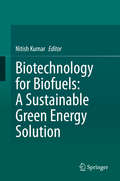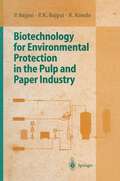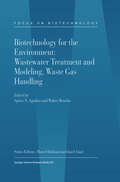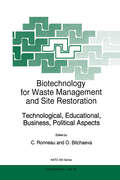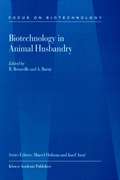- Table View
- List View
Biotechnology for Biofuels: A Sustainable Green Energy Solution
by Nitish KumarThe depletion of petroleum-derived fuel and environmental concerns have prompted many millennials to consider biofuels as alternative fuel sources. But completely replacing petroleum-derived fuels with biofuels is currently impossible in terms of production capacity and engine compatibility. Nevertheless, the marginal replacement of diesel with biofuel could delay the depletion of petroleum resources and abate the radical climate change caused by automotive pollutants. Energy security and climate change are the two major driving forces for worldwide biofuel development, and also have the potential to stimulate the agro-industry. The development of biofuels as alternative and renewable sources of energy has become critical in national efforts towards maximum self-reliance, the cornerstone of our energy security strategy. At the same time, the production of biofuels from various types of biomass such as plants, microbes, algae and fungi is now an ecologically viable and sustainable option. This book describes the biotechnological advances in biofuel production from various sources, while also providing essential information on the genetic improvement of biofuel sources at both the conventional and genomic level. These innovations and the corresponding methodologies are explained in detail.
Biotechnology for Biomedical Engineers (Principles and Applications in Engineering)
by Martin L. Yarmush Mehmet Toner Robert Plonsey Joseph D. BronzinoWith the advent of recombinant DNA technology, monoclonal antibody technology, and new technologies for studying and handling cells and tissues, the field of biotechnology has undergone a tremendous resurgence in a wide range of applications pertinent to industry, medicine, and science in general. A volume in the Principles and Applications in Engi
Biotechnology for Biomedical Engineers (Principles and Applications in Engineering)
by Martin L. Yarmush Mehmet Toner Robert Plonsey Joseph D. BronzinoWith the advent of recombinant DNA technology, monoclonal antibody technology, and new technologies for studying and handling cells and tissues, the field of biotechnology has undergone a tremendous resurgence in a wide range of applications pertinent to industry, medicine, and science in general. A volume in the Principles and Applications in Engi
Biotechnology for Environmental Management and Resource Recovery
by Ramesh Chander Kuhad and Ajay SinghVarious types of secondary agriculture and forestry wastes represent valuable resource materials for developing alternate energy as biofuels and other value added products such as sugars, phenols, furans, organic acids, enzymes and digestible animal feed etc. However, if not managed properly, waste material and environmental contaminants generated by various industries such as food and feed, pulp and paper and textile may lead to severe environmental pollution. The energy, food and feed demand necessitate developing simple and economically viable technologies for environmental management and resource recovery. Microorganisms and their enzymes contribute significantly in utilization of plant residues, resource recovery and eventually in pollution mitigation. “Biotechnology for Environmental Management and Resource Recovery” presents a comprehensive review of selected research topics in a compendium of 16 chapters related to environmental pollution control and developing biotechnologies in agro-ecosystem management and bioconversion of agro-residues (lignocellulosics) into biofuels, animal feed and paper etc. This book provides a valuable resource for reference and text material to graduate and postgraduate students, researchers, scientists working in the area of microbiology, biotechnology, and environmental science and engineering.
Biotechnology for Environmental Protection in the Pulp and Paper Industry
by P. Bajpai R. KondoPulp and paper production has increased globally and will continue to increase in the near future. Approximately 155 million tons of wood pulp is produced worldwide and about 260 million is projected for the year 2010. To be able to cope with increasing demand, an increase in productivity and improved environmental performance is needed as the industry is also under constant pressure to reduce and modify environmental emissions to air and water. The authors give updated information on various biotechnological processes useful in the pulp and paper industry which could help in reducing the environmental pollution problem, in addition to other benefits. Various chapters deal with the latest developments in such areas as raw material preparation, pulping, bleaching, water management, waste treatment and utilization. The book also covers the environmental regulations in various parts of the world as well as the role of biotechnology in reducing environmental problems.
Biotechnology for Fuels and Chemicals: The Twenty-Ninth Symposium (ABAB Symposium)
by William S. Adney James D. McMillan Jonathan R. Mielenz K. Thomas KlassonIn Biotechnology for Fuels and Chemicals: The Twenty-Ninth Symposium, leading US and international researchers from academia, industry, and government exchange cutting-edge technical information and update current trends in the development and application of biotechnology for sustainable production of fuels and chemicals. This symposium emphasizes advances in biotechnology to produce high-volume, low-price products from renewable resources, while improving the environment. The major areas of interest include advanced feedstock production and processing, enzymatic and microbial biocatalysis, bioprocess research and development, opportunities in biorefineries, and commercialization of biobased products. International and domestic progress on producing liquid biofuels, especially ethanol and biodiesel, is highlighted, and related topics, including bioseparations and optimal integration of biochemical and thermochemical conversion technologies, are featured. Forward-looking and authoritative, Biotechnology for Fuels and Chemicals: The Twenty-NInth Symposium provides an illuminating overview of current research and development in the production of commodity fuels and chemicals from renewable biomass resources via biochemical and thermochemical routes.
Biotechnology for Fuels and Chemicals: The Twenty-Eighth Symposium. (ABAB Symposium)
by Jonathan R. Mielenz K. Thomas Klasson William S. Adney James D. McMillanIn Biotechnology for Fuels and Chemicals: The Twenty-Eighth Symposium, leading researchers exchange cutting-edge technical information and update current trends in the development and application of biotechnology for sustainable production of fuels and chemicals. This symposium emphasizes advances in biotechnology to produce high-volume, low-price products from renewable resources, while improving the environment.
Biotechnology for Odor and Air Pollution Control
by Zarook Shareefdeen Ajay SinghHere is the first book on biotechnological processes for controlling odor and air pollution emanating from industrial and municipal airstreams. Authors from academia and industry describe biotechnological methods ranging from those in laboratory stages to pilot evaluation to full-scale process implementation. In addition to the basic microbiology and engineering, the design, modeling, and control of bioreactors are discussed in detail.
Biotechnology for Pulp and Paper Processing
by Pratima BajpaiThe book provides the most up-to-date information available on various biotechnological processes useful in the pulp and paper industry. The first edition was published in 2011, covering a specific biotechnological process or technique, discussing the advantages, limitations, and prospects of the most important and popular processes used in the industry. Many new developments have taken place in the last five years, warranting a second edition on this topic. The new edition contains about 35% new material covering topics in Laccase application in fibreboard; biotechnology in forestry; pectinases in papermaking; stickies control with pectinase; products from hemicelluloses; value added products from biorefinery lignin; use of enzymes in mechanical pulping.
Biotechnology for the Environment: Wastewater Treatment and Modeling, Waste Gas Handling (Focus on Biotechnology #3C)
by Spiros Agathos W. ReinekeAt the dawn of the 21st century, biotechnology is emerging as a key enabling technology for sustainable environmental protection and stewardship. Biotechnology for the Environment: Wastewater Treatment and Modeling, Waste Gas Handling illustrates the current technological applications of microorganisms in wastewater treatment and in the control of waste gas emissions. In the first section of the book special emphasis is placed on the use of rigorous mathematical and conceptual models for an in-depth understanding of the complex biology and engineering aspects underlying the operation of modern wastewater treatment installations. The second part addresses waste gas biofiltration, an expanding biotechnological application of microbial metabolism for air quality assurance through processes ranging from the abatement of hazardous volatile pollutants to the elimination of nuisance odors. It will be a valuable reference source for environmental scientists, engineers and decision makers involved in the development, evaluation or implementation of biological treatment systems. For more information on Strategy and Fundamentals, see Focus on Biotechnology, Volume 3A, and for more information on Soil Remediation, see Focus on Biotechnology, Volume 3B.
Biotechnology for the Treatment of Hazardous Waste
by Daphne L. StonerThe development of biologically based processes for the treatment of hazardous inorganic and organic wastes is a multi-disciplinary effort requiring the consideration of a number of biological, chemical, and physical parameters, as well as the effective teaming of biologists, chemists, engineers, and regulatory agencies. This new text/reference bridges the disciplines in a unique way, allowing an exchange of fundamental information to take place. The book begins with a description of the biological transformations of inorganic and organic compounds and a review of strategies that may be used for the treatment of hazardous wastes. It continues with a discussion of the physiological and engineering factors that must be considered for successful process development and concludes with a discussion of the regulations that have influenced biological waste treatment and environmental remediation.
Biotechnology for the Treatment of Hazardous Waste
by Daphne L. StonerThe development of biologically based processes for the treatment of hazardous inorganic and organic wastes is a multi-disciplinary effort requiring the consideration of a number of biological, chemical, and physical parameters, as well as the effective teaming of biologists, chemists, engineers, and regulatory agencies. This new text/reference bridges the disciplines in a unique way, allowing an exchange of fundamental information to take place. The book begins with a description of the biological transformations of inorganic and organic compounds and a review of strategies that may be used for the treatment of hazardous wastes. It continues with a discussion of the physiological and engineering factors that must be considered for successful process development and concludes with a discussion of the regulations that have influenced biological waste treatment and environmental remediation.
Biotechnology for Treatment of Residual Wastes Containing Metals
by Norma Gabriela Rojas-AvelizapaBiotechnology for Treatment of Wastes Containing Metals addresses various aspects related to different wastes that have a metallic content and represent a serious risk for the environment and human health. These wastes, due to their physical and chemical characteristics, have been the object of studies which have led to the development of different technologies in recycling, reuse or adequate disposal, biotechnology being one of these alternatives. Biotechnology offers a range of options for the treatment of types of waste using microorganisms, biomass and their by-products. The mechanisms involved in these waste treatment processes are diverse and complex, and its optimization and efficiency is multifactorial.This text contains nine chapters related to the problem of the metal contamination in the environment as well as some of the different biotechnological alternatives that have been applied for the reduction and/or recovery of metal contamination.
Biotechnology for Treatment of Residual Wastes Containing Metals
by Norma Gabriela Rojas-AvelizapaBiotechnology for Treatment of Wastes Containing Metals addresses various aspects related to different wastes that have a metallic content and represent a serious risk for the environment and human health. These wastes, due to their physical and chemical characteristics, have been the object of studies which have led to the development of different technologies in recycling, reuse or adequate disposal, biotechnology being one of these alternatives. Biotechnology offers a range of options for the treatment of types of waste using microorganisms, biomass and their by-products. The mechanisms involved in these waste treatment processes are diverse and complex, and its optimization and efficiency is multifactorial.This text contains nine chapters related to the problem of the metal contamination in the environment as well as some of the different biotechnological alternatives that have been applied for the reduction and/or recovery of metal contamination.
Biotechnology for Waste Biomass Utilization
by Prakash K. Sarangi Latika BhatiaThis volume focuses on how waste biomass can be transformed into useful biomaterials, food and feed, fuel, and chemicals by using various processes such as chemical, physical, thermal, biological, and biotechnological procedures. Biomass from biowastes, such as agriculture crop residues, wood processing residues, forest residues, food waste, industrial waste, and municipal solid waste, have emerged as potential substrates for bioenergy production. This volume explores the key features of biotechnology for waste biomass utilization, presenting scientific and technical literature on sustainable waste biomass management as well as for biomass conversion for biofuels, chemicals, and other new commercial products. It discusses a variety of novel biotechnical applications and interventions, including microbial fermentation and anaerobic digestion, biotechnological modes of xylooligosaccharides production, multifaceted utilization of microalgal biomass, vermiculture and vermicomposting, and more. Key features: Provides the most recent information about waste biomass utilization for the production of biofuels and biochemicals Shows a wide range of novel technologies in the field of biotechnology towards waste biomass utilization Focuses on the utilization of microbial resources for waste biomass conversion into value-added products Explores methods for food wastes and crop wastes conversion into biofuels and biochemicals Provides the scientific information describing various examples and case studies which aid gaining knowledge to researchers and academicians With chapters from eminent researchers who have significant global experience in the field of waste biomass management, this volume delivers a wealth of valuable information for researchers involved in bioenergy utilization. It will also be an essential source for academicians, researchers, economists, policymakers, and policy analysts.
Biotechnology for Waste Biomass Utilization
by Prakash Kumar Sarangi Latika BhatiaThis volume focuses on how waste biomass can be transformed into useful biomaterials, food and feed, fuel, and chemicals by using various processes such as chemical, physical, thermal, biological, and biotechnological procedures. Biomass from biowastes, such as agriculture crop residues, wood processing residues, forest residues, food waste, industrial waste, and municipal solid waste, have emerged as potential substrates for bioenergy production. This volume explores the key features of biotechnology for waste biomass utilization, presenting scientific and technical literature on sustainable waste biomass management as well as for biomass conversion for biofuels, chemicals, and other new commercial products. It discusses a variety of novel biotechnical applications and interventions, including microbial fermentation and anaerobic digestion, biotechnological modes of xylooligosaccharides production, multifaceted utilization of microalgal biomass, vermiculture and vermicomposting, and more. Key features: Provides the most recent information about waste biomass utilization for the production of biofuels and biochemicals Shows a wide range of novel technologies in the field of biotechnology towards waste biomass utilization Focuses on the utilization of microbial resources for waste biomass conversion into value-added products Explores methods for food wastes and crop wastes conversion into biofuels and biochemicals Provides the scientific information describing various examples and case studies which aid gaining knowledge to researchers and academicians With chapters from eminent researchers who have significant global experience in the field of waste biomass management, this volume delivers a wealth of valuable information for researchers involved in bioenergy utilization. It will also be an essential source for academicians, researchers, economists, policymakers, and policy analysts.
Biotechnology for Waste Management and Site Restoration: Technological, Educational, Business, Political Aspects (NATO Science Partnership Subseries: 2 #34)
by O. Bitchaeva C. RonneauBiotechnology for Waste Management and Site Restoration covers: waste management - solid, gaseous, liquid; site restoration - radioactivity, organics, toxic metals; educational, economic, social and business aspects; and international collaboration. International collaboration is growing apace and many concrete projects have been started. The body of knowledge is growing. Over the long term, it is envisaged that this international collaboration will result in a long-term scientific and technological strategy, new technologies and alternative solutions, and practical implementations of biotechnology for the nuclear and industrial sectors of the economy.
Biotechnology Fundamentals Third Edition
by Firdos Alam KhanAfter successful launching of first and second editions of Biotechnology Fundamentals, we thought let us find out the feedbacks from our esteemed readers, faculty members, and students about their experiences and after receiving their suggestions and recommendation we thought it would be great idea to write 3rd edition of the book. Being a teacher of biotechnology, I always wanted a book which covers all aspects of biotechnology, right from basics to applied and industrial levels. In our previous editions, we have included all topics of biotechnology which are important and fundamentals for students learning. One of the important highlights of the book that it has dedicated chapter for the career aspects of biotechnology and you may agree that many students eager to know what are career prospects they have in biotechnology. There are a great number of textbooks available that deal with molecular biotechnology, microbial biotechnology, industrial biotechnology, agricultural biotechnology, medical biotechnology, or animal biotechnology independently; however, there is not a single book available that deals with all aspects of biotechnology in one book. Today the field of biotechnology is moving with lightening speed. It becomes very important to keep track of all those new information which affect the biotechnology field directly or indirectly. In this book, I have tried to include all the topics which are directly or indirectly related to fields of biotechnology. The book discusses both conventional and modern aspects of biotechnology with suitable examples and gives the impression that the field of biotechnology is there for ages with different names; you may call them plant breeding, cheese making, in vitro fertilization, alcohol fermentation is all the fruits of biotechnology. The primary aim of this book is to help the students to learn biotechnology with classical and modern approaches and take them from basic information to complex topics. There is a total of 21 chapters in this textbook covering topics ranging from an introduction to biotechnology, genes to genomics, protein to proteomics, recombinant DNA technology, microbial biotechnology, agricultural biotechnology, animal biotechnology, environmental biotechnology, medical biotechnology, nanobiotechnology, product development in biotechnology, industrial biotechnology, forensic science, regenerative medicine, biosimialars, synthetic biology, biomedical engineering, computational biology, ethics in biotechnology, careers in biotechnology, and laboratory tutorials. All chapters begin with a brief summary followed by text with suitable examples. Each chapter illustrated by simple line diagrams, pictures, and tables. Each chapter concludes with a question session, assignment, and field trip information. I have included laboratory tutorials as a separate chapter to expose the students to various laboratory techniques and laboratory protocols. This practical information would be an added advantage to the students while they learn the theoretical aspects of biotechnology.
Biotechnology Fundamentals Third Edition
by Firdos Alam KhanAfter successful launching of first and second editions of Biotechnology Fundamentals, we thought let us find out the feedbacks from our esteemed readers, faculty members, and students about their experiences and after receiving their suggestions and recommendation we thought it would be great idea to write 3rd edition of the book. Being a teacher of biotechnology, I always wanted a book which covers all aspects of biotechnology, right from basics to applied and industrial levels. In our previous editions, we have included all topics of biotechnology which are important and fundamentals for students learning. One of the important highlights of the book that it has dedicated chapter for the career aspects of biotechnology and you may agree that many students eager to know what are career prospects they have in biotechnology. There are a great number of textbooks available that deal with molecular biotechnology, microbial biotechnology, industrial biotechnology, agricultural biotechnology, medical biotechnology, or animal biotechnology independently; however, there is not a single book available that deals with all aspects of biotechnology in one book. Today the field of biotechnology is moving with lightening speed. It becomes very important to keep track of all those new information which affect the biotechnology field directly or indirectly. In this book, I have tried to include all the topics which are directly or indirectly related to fields of biotechnology. The book discusses both conventional and modern aspects of biotechnology with suitable examples and gives the impression that the field of biotechnology is there for ages with different names; you may call them plant breeding, cheese making, in vitro fertilization, alcohol fermentation is all the fruits of biotechnology. The primary aim of this book is to help the students to learn biotechnology with classical and modern approaches and take them from basic information to complex topics. There is a total of 21 chapters in this textbook covering topics ranging from an introduction to biotechnology, genes to genomics, protein to proteomics, recombinant DNA technology, microbial biotechnology, agricultural biotechnology, animal biotechnology, environmental biotechnology, medical biotechnology, nanobiotechnology, product development in biotechnology, industrial biotechnology, forensic science, regenerative medicine, biosimialars, synthetic biology, biomedical engineering, computational biology, ethics in biotechnology, careers in biotechnology, and laboratory tutorials. All chapters begin with a brief summary followed by text with suitable examples. Each chapter illustrated by simple line diagrams, pictures, and tables. Each chapter concludes with a question session, assignment, and field trip information. I have included laboratory tutorials as a separate chapter to expose the students to various laboratory techniques and laboratory protocols. This practical information would be an added advantage to the students while they learn the theoretical aspects of biotechnology.
Biotechnology in Africa: Emergence, Initiatives and Future (Science Policy Reports #7)
by Florence Wambugu Daniel KamangaIn this book, Florence Wambugu and Daniel Kamanga of Africa Harvest Biotech Foundation International bring together expert African authorities to critique various biotechnology initiatives and project future developments in the field in Africa. For the first time, African voices from multidisciplinary fields as diverse as economics, agriculture, biotechnology, law, politics and academia, demand to be allowed to set the continent’s biotech development agenda. This book argues that there is a great future for biotechnology in Africa which sidesteps western interests that do not match those of the local populace. In these diverse chapters, Africa’s political and scientific leaders demand a greater say in how research and development funds are allocated and spent. They argue that Africa’s political leaders must see both clear benefits and have elbow-room to drive the change required. This is the way that African governments can employ workable policies, suitable biosafety legislation and regulation and respond effectively to public-private partnerships. Wambugu and Kamanga show that biotechnology has the potential to improve food security and standard of living as well as mitigate the detrimental effects of climate change on the African continent.
Biotechnology in Agriculture and Food Processing: Opportunities and Challenges
by Parmjit S. Panesar Satwinder S. MarwahaAn instructive and comprehensive overview of the use of biotechnology in agriculture and food production, Biotechnology in Agriculture and Food Processing: Opportunities and Challenges discusses how biotechnology can improve the quality and productivity of agriculture and food products. It includes current topics such as GM foods, enzymes, and prod
Biotechnology in Animal Husbandry (Focus on Biotechnology #5)
by R. Renaville A. BurnyAnimal biotechnology is a broad umbrella encompassing the polarities of fundamental and applied research including molecular modelling, molecular and quantitative genetics, gene manipulation, development of diagnostics and vaccines and manipulation of tissue or digestion metabolism by growth promoters. Although animal biotechnology in the broadest sense is not new, what is new is the level of complexity and precision involved in scientists' current ability to manipulate living organisms. This new book sets out to show that the important ideas in animal biotechnology are exciting and relevant to everyday experience. It represents an important update of the literature for research workers, lecturers, and advisers in animal science, but is also a core text for advanced undergraduate courses in animal science and biotechnology. It will be an essential acquisition for librarians in agriculture and veterinary science.
Biotechnology in Cartoons
by Reinhard Renneberg Viola Berkling Ming-Fai ChowThe book introduces to the basics of biotechnology and lets young and old cartoon fans enjoy science in a relaxed and comprehensive way. Together with Professor Nanoroo, the story's likeable protagonist, the reader discovers on how biotechnology influences our daily life. The real science behind the funny cartoons is explained briefly in separate boxes.The Story:A shooting star falls to Earth in the Kingdom Macronesia.When King Richard VIII. examines the stardust under a super microscope, he discovers a small nanoscopic intelligent being in a micro-spacecraft ... Professor Nanoroo came down from planet Nano to Earth to understand human biotechnology. Curious, he communicates with „Earthlings“, all asking hundreds of questions relating their life.Nanoroo encounters bread baking and beer brewing yeasts; disease makers and health- stabilizing bacteria; fungi producing drugs against bacteria. He experiences many adventures, rescues the king's brother from a heart attack, measures King Richard’s glucose level and the fitness of his racehorses, watches plants with their insect repellents and eats the famous and vitamin-rich „Golden Rice“.The authors:Reinhard Renneberg has been working as Professor of Analytical Biotechnology at the Hong Kong University of Science and Technology (www.ust.hk), the top university of Asia, since 1995. He is the author of several textbooks, including A spoonful of Biotech and Katzenklon, Katzenklon. Along with Viola Berkling, Master of Oriental Languages, he has published already in its fourth edition the extremely successful internationally recognized textbook Biotechnology for Beginners. It is translated into English, Spanish, Chinese, Japanse and Korean. The duo stands for inspiring creative as well as innovative knowledge transfer of accurate, awesome illustrated and non-boring texts from the world of biotechnology.Ming-fai Chow, the Hong Kong cartoonist has created the beautiful and excellent cartoons for this book.Story: Reinhard Renneberg, Viola Berkling, Ming Fai Chow (cartoons)Graphic layout and illustration on academic pages: Dascha SüßbierCartoon coloring: Steffi Kaiser
Biotechnology in China II: Chemicals, Energy and Environment (Advances in Biochemical Engineering/Biotechnology #122)
by G. T. Tsao Pingkai Ouyang Jian ChenPast, Present, and Future Industrial Biotechnology in China, by Zhenjiang Li, Xiaojun Ji, Suli Kan, Hongqun Qiao, Min Jiang, Dingqiang Lu, Jun Wang, He Huang, Honghua Jia, Pingkai Ouyuang, and Hanjie Ying.- Organic Chemicals from Bioprocesses in China, by Jin Huang, Lei Huang, Jianping Lin, Zhinan Xu, and Peilin Cen.- Biofuels in China, by Tianwei Tan, Jianliang Yu, Jike Lu, and Tao Zhang.- Bioreactors and Bioseparation, by Siliang Zhang, Xuejun Cao, Ju Chu, Jiangchao Qian, and Yingping Zhuang.- Environmental Biotechnology in China, by Shuang Jiang Liu , Lei Liu , Muhammad Tausif Chaudhry , Lei Wang , Ying Guang Chen , Qi Zhou , He Liu , and Jian Chen.- Traditional Chinese Biotechnology, by Yan Xu , Dong Wang , Wen Lai Fan , Xiao Qing Mu, and Jian Chen.- Modern Biotechnology in China, by Qing-Zhao Wang and Xue-Ming Zhao.
Biotechnology in China III: Biofuels and Bioenergy (Advances in Biochemical Engineering/Biotechnology #128)
by Feng-Wu Bai, Chen-Guang Liu, He Huang and George T TsaoCellulolytic Enzyme Production and Enzymatic Hydrolysis for Second-Generation Bioethanol Production, by Mingyu Wang, Zhonghai Li, Xu Fang, Lushan Wang und Yinbo Qu Bioethanol from Lignocellulosic Biomass, by Xin-Qing Zhao, Li-Han Zi, Feng-Wu Bai, Hai-Long Lin, Xiao-Ming Hao, Guo-Jun Yue und Nancy W. Y. Ho Biodiesel From Conventional Feedstocks, by Wei Du und De-Hua Liu Establishing Oleaginous Microalgae Research Models for Consolidated Bioprocessing of Solar Energy, by Dongmei Wang, Yandu Lu, He Huang und Jian Xu Biobutanol, by Hongjun Dong, Wenwen Tao, Zongjie Dai, Liejian Yang, Fuyu Gong, Yanping Zhang und Yin Li Branched-Chain Higher Alcohols, by Bao-Wei Wang, Ai-Qin Shi, Ran Tu, Xue-Li Zhang, Qin-Hong Wang und Feng-Wu Bai Advances in Biogas Technology, by Ai-Jie Wang, Wen-Wei Li und Han-Qing Yu Biohydrogen Production from Anaerobic Fermentation, by Ai-Jie Wang, Guang-Li Cao und Wen-Zong Liu Microbial Fuel Cells in Power Generation and Extended Applications, by Wen-Wei Li and Guo-Ping Sheng Fuels and Chemicals from Hemicellulose Sugars, by Xiao-Jun Ji, He Huang, Zhi-Kui Nie, Liang Qu, Qing Xu and George T. Tsao
